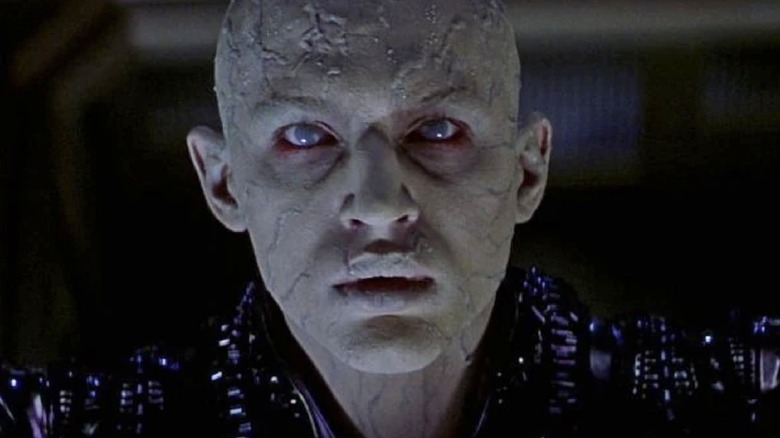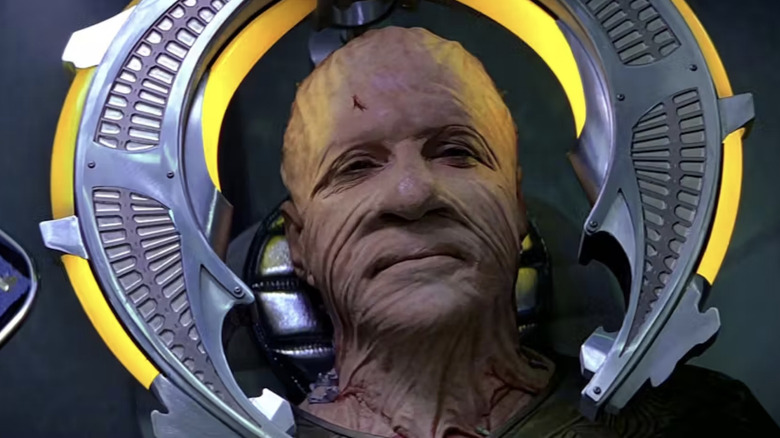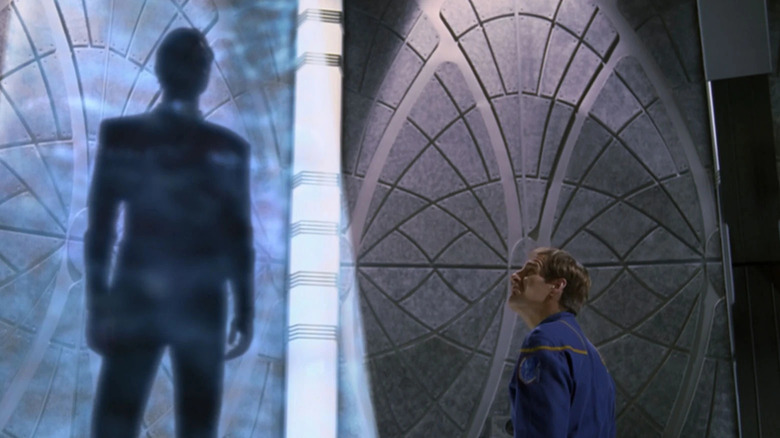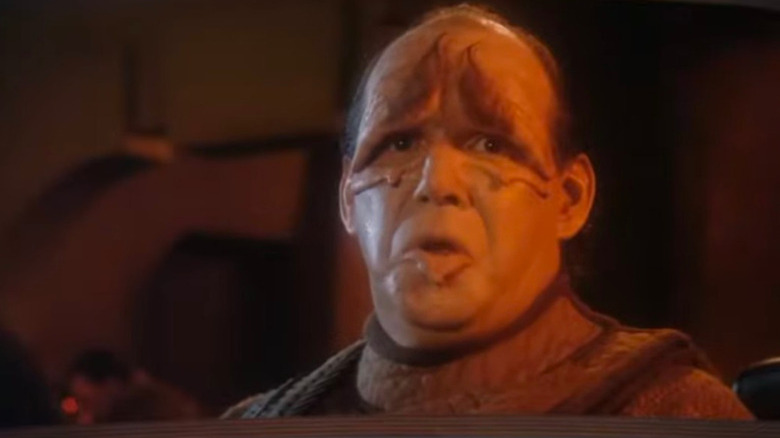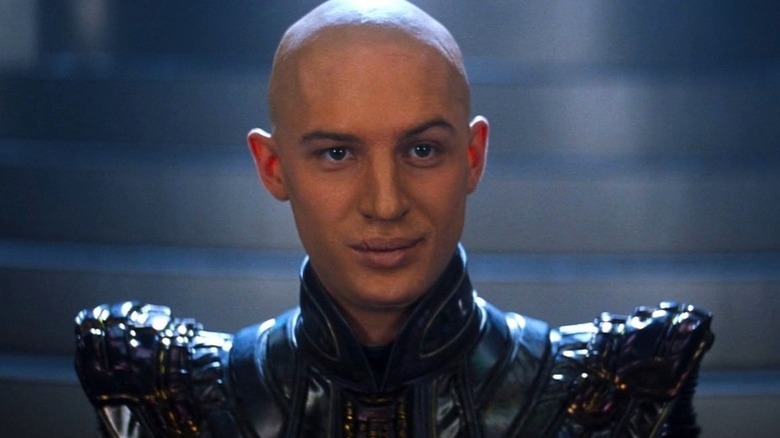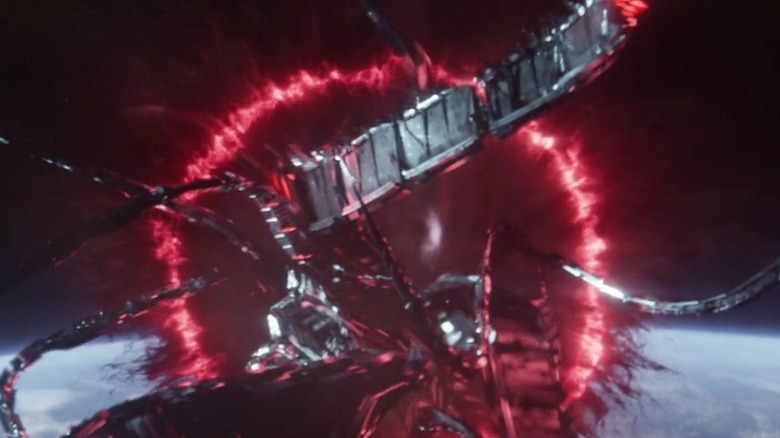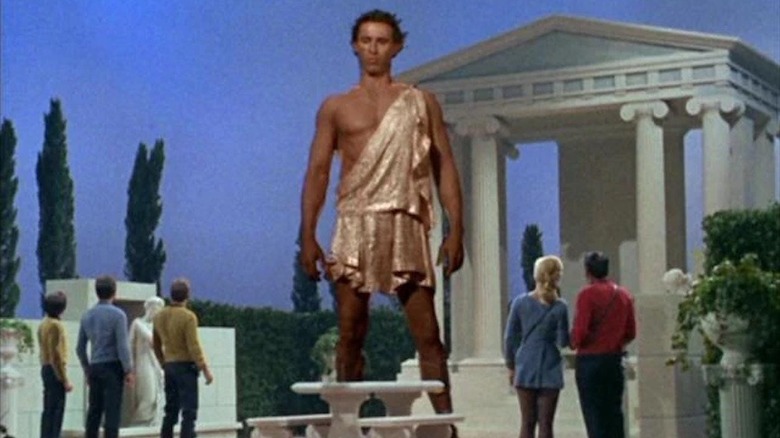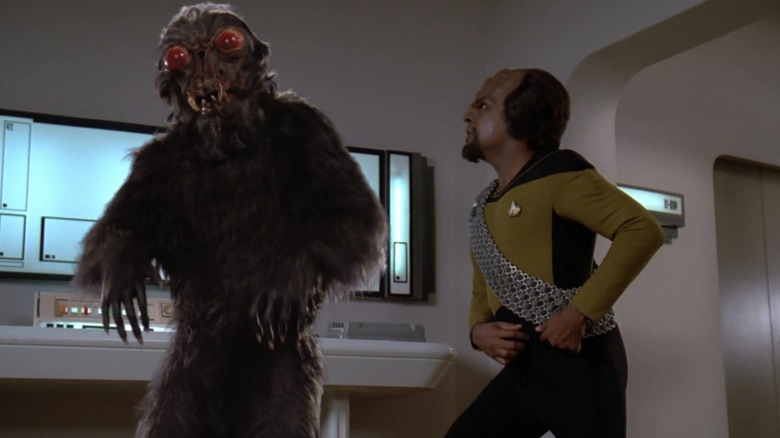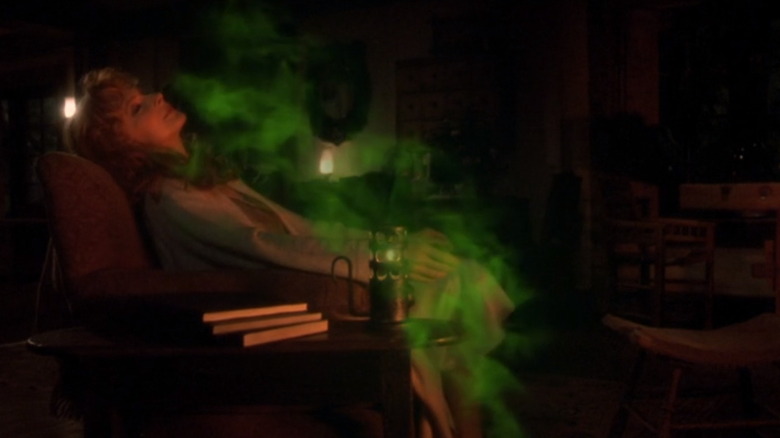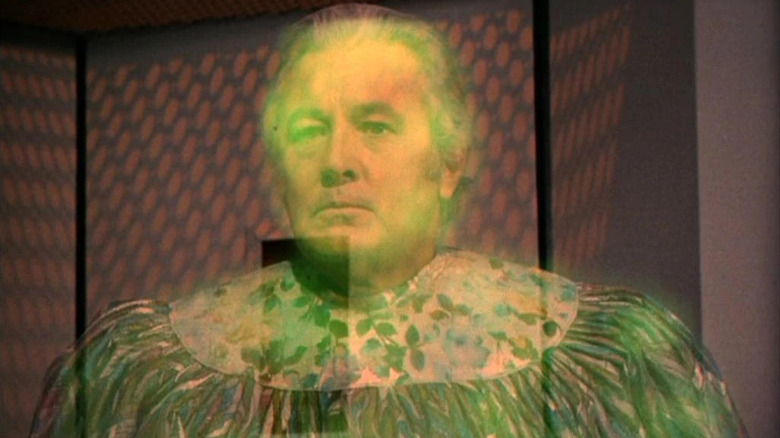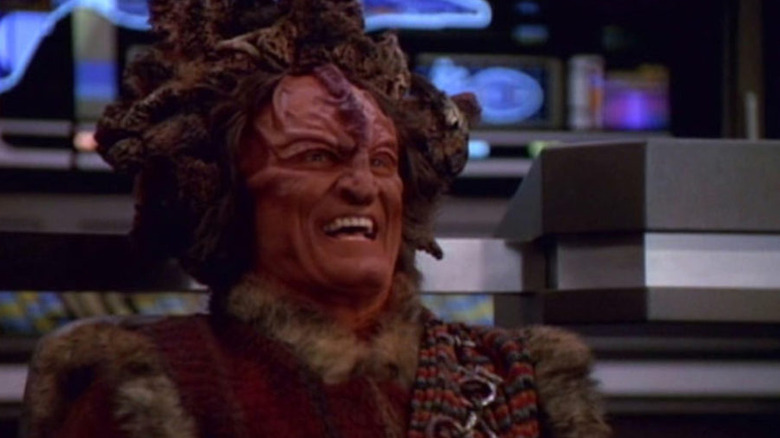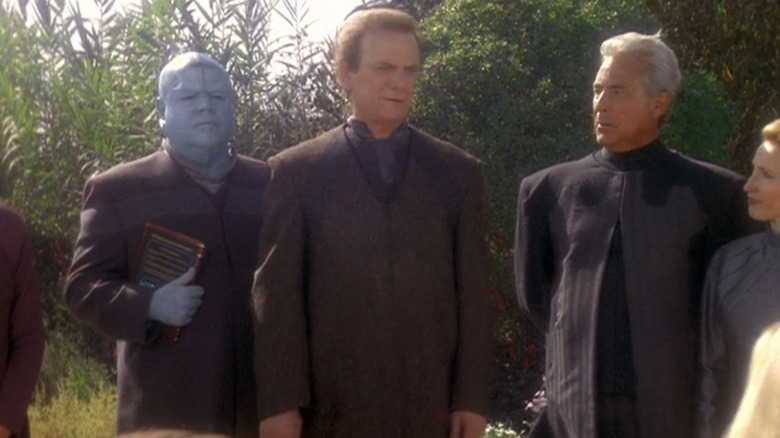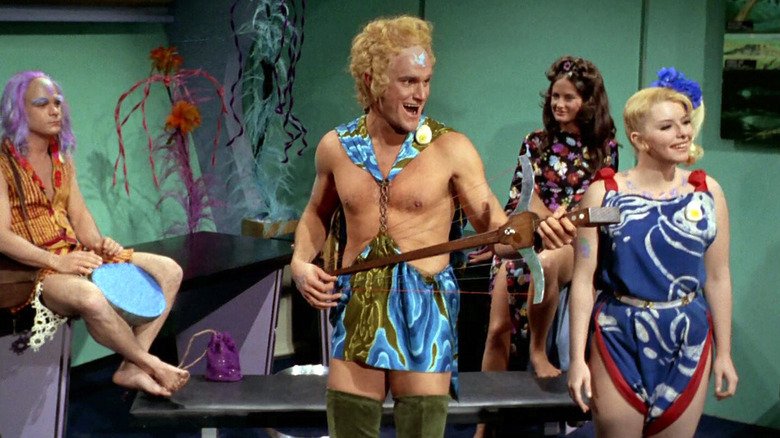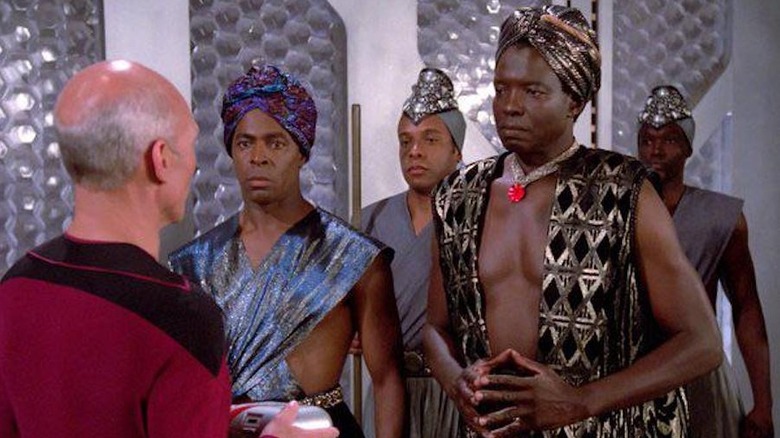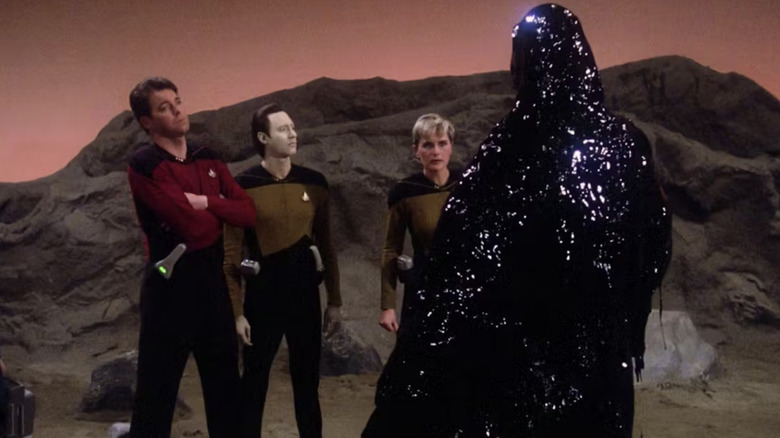The 15 Worst Star Trek Villains Of All Time, Ranked
"Star Trek" boasts some of the greatest villains in the history of science fiction, characters whose legends go beyond the genre. From the Borg and the Klingons to evil tyrants like Khan, even non-fans remember the greatest baddies from "Star Trek" and its dozens of TV shows and movies. But make no mistake, for every great villain we've seen from the franchise, there's one that is so horrifically abysmal that fans can only hope that they remain buried, lest the world learn just how awful some of the worst villains in "Star Trek" can get.
Whether it's an alien race that showed up for just one story, or a singular arch-villain who became a recurring character — and everything in between — we've sifted through every "Star Trek" series and movie to find the 15 lamest losers of the bunch. Maybe they were disappointing threats that amounted to nothing, or just plain eye-rolling — or in at least one case, downright offensive. So set phasers to stun and the transporter for deep space, because this is a list of the worst villains in "Star Trek" history.
15. The Son'a
When a TV franchise goes to the movies, it requires a villain worthy of the big screen: someone larger than life who can give our heroes enough trouble to make the story feel like a major event. Unfortunately, the villain in 1998's "Star Trek: Insurrection" wasn't that. They were the Son'a, a race of aliens seeking immortality, whose leader Ru'afo (F. Murray Abraham) uses bizarre forms of plastic surgery to stay "young."
Not only are the Son'a completely ineffectual, unable to give the Enterprise much of a fight, but their plan doesn't make a lot of sense: They want to forcibly relocate a humanoid species, the Ba'ku, from their home world in order to extract resources from the planet that they believe are the key to immortality. Sure, there's a lot of talk about how dangerous the Son'a are — and the twist that they are an offshoot of the Ba'ku themselves is a decent head-turner late in the film — but as villains, their greatest crime is how forgettable they are, ruining what had at least some potential for a decent "Trek" movie.
14. Future Guy
Keeping a villain off-screen can sometimes make them more mysterious and even more frightening. It's true in monster movies and conspiracy thrillers, and "Star Trek: Enterprise" tried this trick when the series launched in 2001 with the introduction of the affectionately nicknamed "Future Guy." An apparition seen only in silhouette, Future Guy is said to be a diabolical villain from the future communicating orders to his henchmen in the past as part of a plot to change history to suit his whims.
Unlike most off-screen villains, however, Future Guy is anything but intimidating. His plans never amount to much, we get conflicting clues as to who or what he might actually be, and the show's attempts to feature a compelling ongoing mystery fall completely flat. Despite the series making a big deal about Future Guy early in the first season, it becomes a discarded storyline by the end of Season 3, and we never actually learn who he was or why he wanted to destroy the Federation. Not just one of the worst "Trek" villains, Future Guy is easily the most disappointing, too.
13. The Pakled
When it launched in 1987, "Star Trek: The Next Generation" tried to broaden the scope of the franchise's villains with an array of new and diverse adversaries for the crew of the USS Enterprise. Sadly, most of the early ones were sorely lacking in the threat department, with enemies like the Ferengi eventually becoming little more than comic relief. But the most baffling of the bunch might be the Pakled, a horribly misguided attempt to give representation to the intellectually challenged.
Captain Picard (Patrick Stewart) and crew encounter the slow-witted Pakled, who seem to not even understand how their own ship operates, in the episode "Samaritan Snare." It turns out that it's all a ruse to lure the Enterprise into a trap, but their dim nature isn't a trick — they really do lack intelligence and common sense, and they are quickly outmaneuvered.
Though we'd already met a race of seemingly dimwitted aliens in Season 1's "Symbiosis," that episode at least had an important message about drug addiction. So what were the Pakled really trying to teach us? That those with cognitive impairments are also dangerous?
12. Shinzon
The crew of "The Next Generation" really struggled with villains on the big screen, outside of the insidious Borg Queen in "Star Trek: First Contact." The disappointment of the Son'a in "Insurrection" was followed in 2002's "Star Trek: Nemesis" with Shinzon, the living embodiment of Millennial edgelord angst. Yes, Shinzon is played by Tom Hardy in one of his first roles (and he was so awkward on set that Patrick Stewart avoided him). But Hardy's the only reason why Shinzon isn't higher on this list, because the villain is arguably the lamest duck in the franchise.
A character written as an emo nepo baby, Shinzon is a clone of Captain Picard who suffers from a debilitating disease. While leading a rebellion inside the Romulan Empire, he kidnaps Picard to steal his blood and keep himself alive. But the character is written so badly, so haphazardly, that he comes across like he's trying too hard to be sinister, and ultimately winds up anything but. We're meant to sympathize with Shinzon's quest for vengeance against his oppressors, but we never really do, while his mind-rape of Deanna Troi (Marina Sirtis) is the sour cherry on top of the cringe sundae.
11. The Synth Beings
Evil, artificially intelligent machines are a staple of "Star Trek," going from the likes of Nomad in the original series to the comedically sinister Agimus on "Star Trek: Lower Decks." The evils of AI reared their heads again in Season 1 of "Star Trek: Picard" in 2020, in a story centered on the life and death of the android Commander Data (Brent Spiner), as a diabolical synthetic life form from another realm threatens to destroy all life in the galaxy.
For most of that season, these evil synths loomed as an unseen spectre whose impending arrival would signal the end of sentient organic life. It's even said that the Romulans have been preparing for the arrival for centuries and have been doing everything in their power to see that it never comes. It's a compelling idea, perhaps, but one that, in execution, lacked any sense of genuine dread. And at some point, it's better if we never glimpse the unseen threat at all — because a bunch of random metal tentacles doesn't cut it. In the end, what we get is so vague and cartoonish that it sucks out all sense of genuine peril.
10. Apollo
No, we're not talking about Carl Weathers from the "Rocky" films here, but the actual Greek god Apollo. Believe it or not, non-Trekkies, Apollo indeed showed up in "Star Trek," way back in the 1960s, when the concept of a "big idea" villain literally meant a giant, half-dressed man shooting lightning from his fingertips. And that's exactly who the antagonist is in the episode "Who Mourns for Adonais?," where we meet Apollo (Michael Forest) — an alien who visited Earth ages ago and was worshiped as a deity by the ancient Greeks — as a jumbo-sized man who torments Kirk and his crew.
It all goes down on the planet Pollux IV, which, wouldn't you know it, turns out to be the mythical Greek realm of Olympus where all those major gods hang out — from Zeus and Aphrodite to Hades and indeed Apollo. As Greek figures of legend, they are usually portrayed in fiction as mighty, powerful beings whose command over the forces of nature makes them truly frightening to mere mortals. But Apollo here is the exact opposite of frightening, acting more like a bratty teenager — a cheap-looking B-movie baddie who pouts like he's going for a career as a social media influencer.
9. The Waadi
When it comes to sheer lameness, there are few villains in "Star Trek" history that can compare to the Waadi, the antagonists of the notoriously awful "Star Trek: Deep Space Nine" episode "Move Along Home." The episode is famous in "Trek" circles for being overly goofy and downright groan-inducing at times, and the Waadi are a big reason why.
The episode sees Commander Sisko (Avery Brooks) and other crew members trapped inside a virtual game brought to the station by the Waadi, an alien race from the other side of the Bajoran wormhole. It's technically a first contact mission, so Sisko and the gang treat them like visiting dignitaries, but the game that they suddenly find themselves trapped in puts them in a life-or-death situation. The big twist, however, is that the game isn't a threat at all, and it was all for fun — making the Waadi less villains as much as silly tricksters with bad mullets and funny tattoos on their foreheads because the makeup department got too cheap for latex bumps.
8. The Dauphin
It's no secret that "Star Trek: The Next Generation" had the worst first season of any series in the franchise, but its second year is also filled with a string of awful episodes. Chief among them is "The Dauphin," an episode centered on Wesley Crusher (Wil Wheaton) and his first teenage crush, a mysterious young girl named Salia (Jaime Hubbard), who turns out to be a terrifying shapeshifting creature known as an allasomorph.
Salia isn't the villain of the piece; her guardian Anya (Paddi Edwards) is. She too is an allasomorph, and takes the guise of a giant, multi-clawed creature to threaten those who might do Salia harm. Some of the show's worst creature effects are on display in "The Dauphin," with the monster looking like something out of a furry convention. It never feels at all threatening, even when swatting aside Klingon warrior Worf (Michael Dorn). Salia's monster form is even less frightening: a giant orange Sleestak-looking thing that looks slapped together from old carpet samples.
7. Ronin, the Candle Ghost
It should come as no surprise that many of the worst villains in "Star Trek" hail from the worst episodes the franchise has ever seen, and that means we'd be remiss not to include Ronin, the candle ghost from the infamously awful "Next Generation" episode "Sub Rosa." A truly mind-bogglingly weird installment that sees Dr. Beverly Crusher (Gates McFadden) falling in love with a non-corporeal entity that resides in an old Scottish candle, "Sub Rosa" plays more like a piece of erotic fan fiction than an actual "Star Trek" episode.
"Ronin" is the name given to the ghost's physical form: a dashing, square-jawed man (Duncan Regehr) who has been seducing the women in Crusher's family for generations and draining them of their life force. Ronin's true form, however, is a green energy mist that lives inside the candle, an heirloom passed down through the family line. After the death of her grandmother, the good doctor inherits the candle, and Ronin seduces Beverly, too. A laughable villain in a laughable story, Ronin never feels very threatening and doesn't even appear to be very good at haunting anything.
6. Gorgan
The original "Star Trek" series had its share of iconic baddies, from the Klingons and the Gorn to Khan Noonien Singh and Harry Mudd. But the Gorgan from "And the Children Shall Lead" is easily among the worst villains to come out of that legendary 1960s series. The episode sees Kirk (William Shatner) and the Enterprise arrive at the site of a scientific research expedition to find the entire team dead, but five happy children seemingly unfazed by the death of their parents.
After the children are brought to the Enterprise, they summon a phantom named Gorgan, who instructs them to take over the ship and transport him to another world where he will gather millions of new followers in his quest to conquer the galaxy. It's a half-hearted story with the simplest of scripts, but the apparition that calls itself Gorgan might be the worst part of it. Played by celebrity attorney Melvin Belli, Gorgan appears as a rotund gentleman clad in a shiny garbage bag — but in the end is revealed to be an even uglier rotund gentleman in a dirtier garbage bag. Try again, fellas, this one ain't it.
5. The Kazon
Every "Star Trek" captain has their rival alien race: Kirk has the Klingons, Picard has the Borg, and Sisko has the Dominion. But when the producers of "Star Trek: Voyager" set out to create a primary alien adversary for Captain Janeway (Kate Mulgrew), they took a big whiff with the Kazon, a war-like species that landed with the thud of a wet rag. Mockingly referred to as "broccoli heads" by fans, the Kazon were a clear attempt to try to emulate the Klingons, with warring houses and honorable combat.
The problem, however, is that they were never that fearsome to begin with; They were mostly just a nuisance to Janeway — they lacked advanced technology, they weren't all that tough in a fight, and they were so pathetic that even the Borg wouldn't assimilate them because they had nothing meaningful to offer the collective. Toss in the hammy performances from the actors under the makeup that often bordered on vaudevillian, and you begin to wonder how they lasted on the show past the series premiere. Like the Ferengi, it might have been wiser to turn them into comic relief, because they were already the show's most farcical foes right out of the gate.
4. Pascal Fullerton and the New Essentialists
You'd be forgiven for not even remembering these villains by name thanks to their appearance in what is not just the worst episode of "Star Trek: Deep Space Nine," but ultimately one that's completely unmemorable thanks to its sheer blandness. We're talking about the episode "Let He Who is Without Sin," in which Worf and Dax (Terry Farrell) vacation on the pleasure planet Risa, with Doctor Bashir (Alexander Siddig), Dabo girl Leeta (Chase Masterson), Rom (Max Grodenchik), and Quark (Armin Shimerman) all tagging along for good measure.
Worf makes no secret of his disdain for the entire trip, and he gets some sorely needed confirmation bias when the guests on Risa are visited by the New Essentialists. Led by a man named Pascal Fullerton (Monte Markham), the New Essentialists believe that life in the Federation has made people soft, and seeks to sabotage the planet's weather control system to show everyone how miserable the rain is. Seriously, that's their plan. While they do succeed in ruining everyone's vacation, all it amounts to is some soggy bread and indoor chess.
3. The space hippies
In the category of "worst villains," there are the ones that fail to deliver a real threat and the ones that don't make a lot of sense — and then the ones that are just plain stupid. Qualifying as all three is the group of space hippies who visit the Enterprise in the woeful 1969 installment "The Way to Eden." In a story that makes it seem like the writers thought hippie culture was going to destroy all of humanity, Kirk and crew pick up a gang of peace-loving, music-playing young people who are on a fanatical quest for a literal paradise.
Look, there's really no other way to put it: The ultra-campy space hippies from "The Way to Eden" are just plain stupid and have aged terribly. Sure, there were those who saw hippies as a threat thanks to violent activist groups like the Weather Underground in the 1970s. But there was nothing at all dangerous about these folks here, who attempt a takeover of the Enterprise by hypnotizing the crew with space hippie music — which is every bit as dumb as it sounds.
2. Lutan and the Ligonians
No, we're not talking about a new wave group from the 1980s, but some of the most awkwardly executed racial stereotypes you'll ever see on screen. Originating in "The Next Generation" Season 1 episode "Code of Honor" — an episode so bad that Jonathan Frakes called it an embarrassment — the Ligonians could rightly claim the top spot on this list simply for how offensive they are, in what is unquestionably the most uncomfortable watch in "Star Trek" history
An alien culture with artificially heavy accents, portrayed by all Black actors — who Picard openly says reminds him of "an ancient Earth culture" — the Ligonians are the worst and most disrespectful African cliches imaginable. An unintelligent, primitive, and savagely warlike people who fight to the death over women, the Ligonians are led by Lutan, played by actor Jessie Lawrence Ferguson, who was somehow convinced to give a backwards, comically racist performance. But it goes beyond the uncomfortable portrayal, because nothing about Lutan and the Ligonians makes much sense and they don't seem to pose any kind of genuine threat.
It's hard to imagine a villain in "The Next Generation" could get any worse than the Ligonians. But they also make us question the attitudes of the episode's writers. What were they thinking?
1. Armus
Yes, there's a villain worse than the Ligonians, and while it has the excuse of a rushed script written only to accomodate actor Denise Crosby's desire to leave the series, there's really no way a "Trek" villain gets any worse than Armus in "Skin of Evil," from Season 1 of "The Next Generation." Literally a pile of black goo, Armus is a creature on a remote world created to be the embodiment of pure evil. And he kills Crosby's Lieutenant Tasha Yar in what is, without a doubt, the silliest death of a series regular in the franchise, and one of the most hated moments from "TNG."
After killing Yar, Armus holds an injured Deanna Troi hostage, not allowing anyone to come to her aid. Despite a lack of clear powers, he's somehow able to suck Commander Riker (Jonathan Frakes) into his river of black goo, and, with little explanation, keep an entire team of armed Starfleet officers at bay. It's the kind of enemy created solely to serve a narrative purpose (in this case, killing Yar), with little thought given to anything else. A menace and an episode with no redeeming qualities, Armus tops our list as the worst villain in "Star Trek" history.
